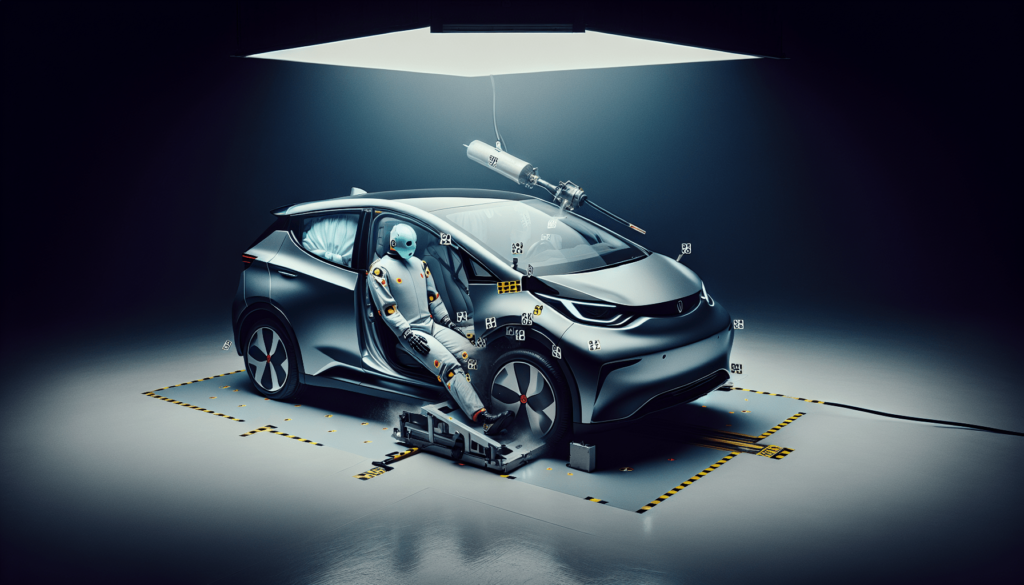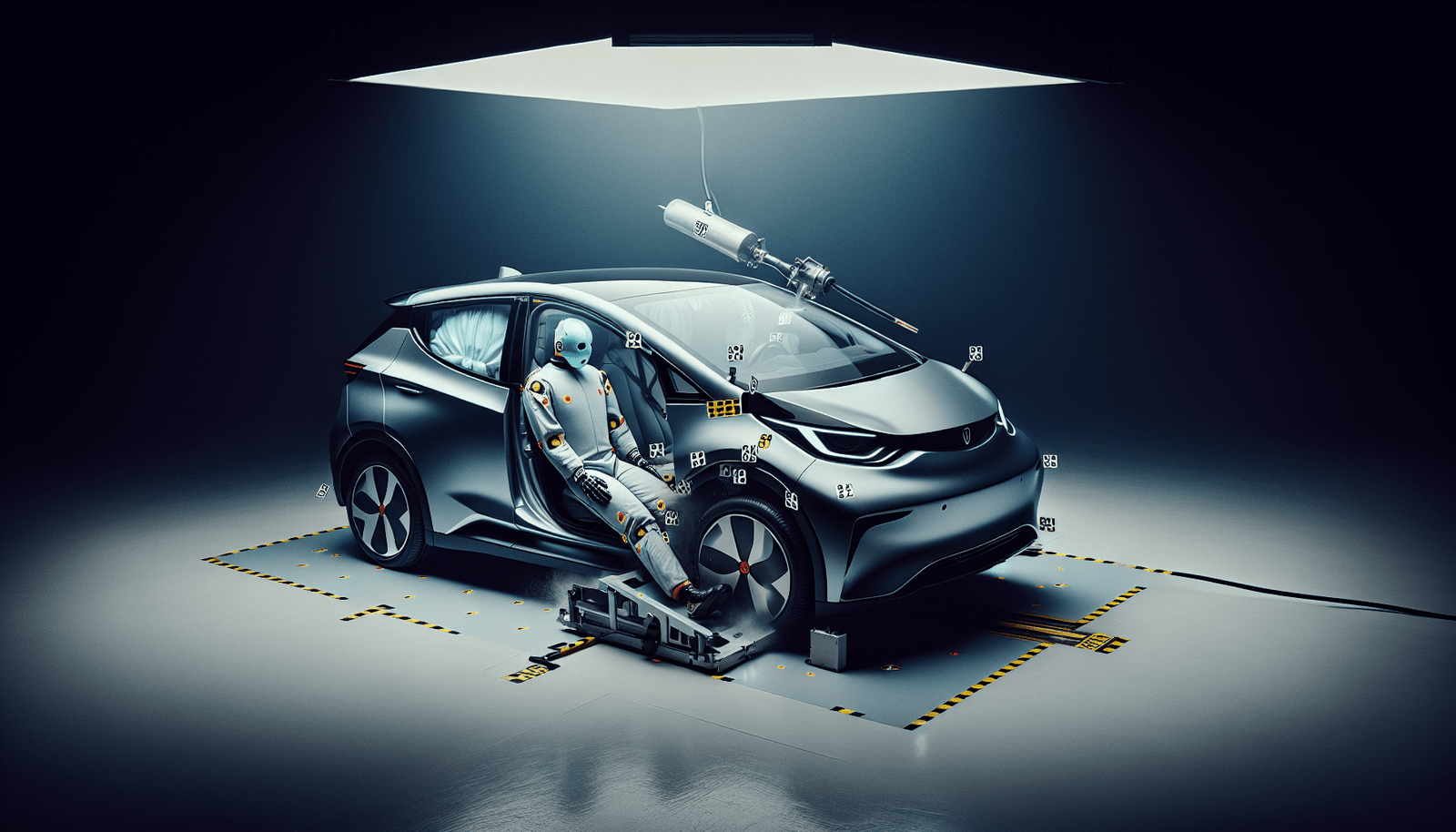When it comes to the safety of electric vehicles, you may be wondering how they measure up in terms of safety features and crash test ratings. With the rise in popularity of electric vehicles, it is important to understand how they stack up in terms of protecting both the driver and passengers. In this article, we will explore the various safety features incorporated in electric vehicles and delve into the crash test ratings to provide you with a comprehensive overview of their safety capabilities. So, fasten your seatbelts and get ready to embark on a journey to discover how electric vehicles fare when it comes to safety.
Crash Test Ratings
Overview of Crash Test Ratings
Crash test ratings are an important aspect to consider when it comes to evaluating the safety of a vehicle. These ratings are designed to assess how well a vehicle can protect its occupants in the event of a collision. They provide valuable information to consumers, allowing them to make informed decisions when purchasing a new vehicle.
Importance of Crash Test Ratings
Crash test ratings play a crucial role in ensuring the safety of both drivers and passengers. By providing a standardized evaluation of a vehicle’s crashworthiness, these ratings help consumers identify which vehicles offer the highest level of protection in real-world accidents. They give consumers the confidence that their chosen vehicle has been thoroughly tested and meets the necessary safety standards.
Different Crash Test Rating Programs
There are several crash test rating programs that evaluate the safety of vehicles. Each program follows its own set of criteria and testing procedures. Some of the most well-known rating programs include the National Highway Traffic Safety Administration (NHTSA), Insurance Institute for Highway Safety (IIHS), Euro NCAP, and China New Car Assessment Program (C-NCAP). These programs have their own unique methodologies and standards, but all aim to provide consumers with reliable information regarding a vehicle’s crashworthiness.
Safety Features
Overview of Safety Features
Safety features in vehicles are designed to minimize the risk of injury to occupants in the event of a collision. They can be categorized into two main types: passive safety features and active safety features. Passive safety features are designed to protect occupants during a collision, while active safety features aim to prevent accidents from happening in the first place.
Passive Safety Features
Passive safety features include components such as seat belts, airbags, and structural design. Seat belts are a fundamental safety feature that helps restrain occupants during a collision, minimizing the risk of severe injuries. Airbags, on the other hand, provide an additional layer of protection by deploying rapidly upon impact and helping to reduce the force of the collision on the occupants. The structural design of a vehicle also plays a critical role in passive safety, with features such as crumple zones and reinforced frames absorbing and dispersing the energy of a collision, thereby protecting the occupants.
Active Safety Features
Active safety features are designed to help prevent accidents from occurring. These features often utilize advanced technologies to assist drivers in maintaining control of the vehicle and avoiding potential hazards. Examples of active safety features include anti-lock braking systems (ABS), electronic stability control (ESC), and forward collision warning (FCW) systems. These features work together to enhance the safety of the vehicle by providing early warning signs and assistance to drivers, reducing the likelihood of accidents and improving overall safety on the road.

Crashworthiness
Definition of Crashworthiness
Crashworthiness refers to a vehicle’s ability to protect its occupants during a collision. It involves both the structural integrity of a vehicle and the effectiveness of its safety features. A crashworthy vehicle is designed to absorb and dissipate the energy generated during a collision, reducing the risk of injuries to the occupants.
Factors Affecting Crashworthiness
Several factors can impact a vehicle’s crashworthiness. These include the structural design and materials used in the vehicle’s construction, as well as the effectiveness of its safety features. A well-designed vehicle with strong structural components and advanced safety features is more likely to provide better protection to its occupants in the event of a crash.
Importance of Crashworthiness in Electric Vehicles
Crashworthiness is of paramount importance in electric vehicles (EVs) due to the unique characteristics of these vehicles. EVs often have large battery packs, which can pose additional risks in the event of a collision. A well-designed and crashworthy EV is critical to mitigate these risks and ensure the safety of the vehicle’s occupants. As the popularity of EVs continues to rise, manufacturers are paying increasing attention to crashworthiness to maintain consumer confidence in the safety of these vehicles.
Crash Test Rating Programs
National Highway Traffic Safety Administration (NHTSA)
The National Highway Traffic Safety Administration (NHTSA) is a U.S. government agency responsible for promoting and enforcing vehicle safety standards. The NHTSA conducts various crash tests and provides safety ratings for vehicles. Its 5-star safety rating system is widely recognized and used by consumers to evaluate the crashworthiness and safety features of vehicles.
Insurance Institute for Highway Safety (IIHS)
The Insurance Institute for Highway Safety (IIHS) is a nonprofit organization dedicated to reducing injuries, deaths, and property damage from motor vehicle crashes. The IIHS conducts rigorous tests on vehicles and rates them based on their performance in a range of crash scenarios. The IIHS rating system is highly regarded and provides consumers with valuable information about a vehicle’s crashworthiness and safety features.
Euro NCAP
Euro NCAP (European New Car Assessment Program) is an independent organization that assesses the safety performance of cars in Europe. Euro NCAP conducts comprehensive crash tests and rates vehicles based on their performance in various scenarios. Euro NCAP ratings are widely used by European consumers to gauge the safety of vehicles and compare different models.
China New Car Assessment Program (C-NCAP)
The China New Car Assessment Program (C-NCAP) is a government-backed organization that evaluates the safety performance of vehicles in China. C-NCAP conducts tests similar to those carried out by other crash test rating programs, and its ratings are used by Chinese consumers to determine the safety level of vehicles available in the Chinese market.

Comparison of Electric Vehicles to Internal Combustion Engine (ICE) Vehicles
Safety Differences between Electric and ICE Vehicles
When comparing the safety features of electric vehicles to internal combustion engine (ICE) vehicles, there are few inherent differences. Electric vehicles tend to have a lower center of gravity due to their battery packs being located at the bottom of the vehicle, which can enhance stability and reduce the risk of rollovers. Additionally, electric vehicles often have advanced driver-assistance systems (ADAS), which can further enhance safety by providing automatic emergency braking, lane keeping assistance, and other features.
Crash Test Ratings of Electric Vehicles vs ICE Vehicles
Electric vehicles generally perform well in crash tests and often receive high crash test ratings. This is due to the use of advanced materials and structural designs, as well as the inclusion of the latest safety technologies. However, the crash test ratings of any vehicle, whether electric or ICE, may vary depending on the specific make and model being evaluated. It is important for consumers to refer to the crash test ratings provided by reliable rating programs, such as the NHTSA or IIHS, to make informed decisions about the safety features of a vehicle.
Advanced Safety Technologies in Electric Vehicles
Autonomous Emergency Braking (AEB)
Autonomous Emergency Braking (AEB) is a safety feature that can be found in many electric vehicles. It uses sensors and cameras to detect potential collisions and automatically applies the brakes to prevent or mitigate the impact. This technology is particularly useful in urban environments, where pedestrians and cyclists may suddenly cross the path of a vehicle.
Lane Departure Warning (LDW)
Lane Departure Warning (LDW) systems are designed to help prevent accidents caused by unintentional drifting out of the lanes. In electric vehicles, LDW systems use sensors to monitor lane markings and provide visual and auditory alerts to the driver if the vehicle starts to veer out of its lane without the use of turn signals. This feature helps promote safer driving by keeping the vehicle within its designated lane.
Forward Collision Warning (FCW)
Forward Collision Warning (FCW) systems are designed to alert drivers of potential collisions with vehicles or obstacles ahead. Using sensors, these systems monitor the distance and relative speed between the vehicle and objects in front. If a potential collision is detected, the FCW system will provide visual and auditory warnings to the driver, allowing them to take evasive action if necessary.
Blind Spot Detection (BSD)
Blind Spot Detection (BSD) systems are particularly useful in heavily trafficked areas, where vehicles can easily go unnoticed in a driver’s blind spot. BSD systems use sensors to monitor the vehicle’s blind spots and provide visual or auditory alerts when a vehicle is detected in these areas. By alerting drivers of the presence of another vehicle, BSD systems help reduce the risk of collision while changing lanes.
Pedestrian Detection Systems
Pedestrian Detection Systems use sensors and cameras to detect pedestrians in the vicinity of a vehicle and provide warnings to the driver if a potential collision is imminent. These systems are especially important for electric vehicles, as their quieter drivetrains may make it harder for pedestrians to hear approaching vehicles. Pedestrian detection systems help improve safety by reducing the likelihood of accidents involving pedestrians.
Battery Safety in Electric Vehicles
Battery Design and Engineering for Safety
Battery safety is a critical aspect of electric vehicles. Manufacturers invest considerable resources in designing and engineering batteries to be as safe as possible. This includes implementing measures such as thermal management systems, fail-safe mechanisms, and battery cell design optimizations to minimize the risk of thermal runaway and other potential hazards.
Fire Safety and Flame Retardancy Measures
Electric vehicle batteries are designed with fire safety in mind. Battery packs are equipped with flame retardant materials and built-in fire suppression systems to contain and extinguish fires in the event of a thermal event. Additionally, efforts are made to design battery enclosures that can withstand impact and prevent external damage that could compromise battery safety.
Crash-Induced Safety Systems for Battery Protection
To further enhance battery safety, electrical vehicles are equipped with crash-induced safety systems. These systems are designed to detect crashes and automatically disconnect the high-voltage battery to minimize the risk of electric shock or fire. The crash-induced safety systems also help protect the integrity of the battery pack and prevent further damage in the event of a collision.
Safety Concerns and Challenges for Electric Vehicles
Battery Fire Risk
One of the primary safety concerns associated with electric vehicles is the risk of battery fires. While rare, high-profile incidents have led to concerns about the safety of lithium-ion batteries. Manufacturers are continuously working to improve battery designs and implement safety measures to minimize these risks. However, it is important for proper charging and maintenance practices to be followed to mitigate the chances of battery fires.
Emergency Responder Training
With the increasing prevalence of electric vehicles on the road, it is crucial for emergency responders to receive proper training to safely handle incidents involving these vehicles. The unique characteristics and high-voltage systems of electric vehicles require specialized knowledge and equipment for effective response and rescue operations. Adequate training ensures that emergency personnel are equipped to handle any potential safety risks associated with electric vehicles.
Lack of Standardized Safety Measures
As electric vehicles continue to evolve, there is a need for standardized safety measures to be established. While crash test programs exist to evaluate the safety of vehicles, there is still a lack of universal standards and protocols specific to electric vehicles. Standardization would enhance consumer confidence and ensure consistent safety standards across all electric vehicle models.
Government Regulations and Standards for Electric Vehicle Safety
Current Safety Regulations for Electric Vehicles
Government agencies around the world have implemented safety regulations and standards to ensure the safety of electric vehicles. These regulations cover various aspects of electric vehicle safety, including crashworthiness, battery safety, and charging infrastructure standards. Manufacturers must comply with these regulations to ensure their vehicles meet established safety requirements.
Evolving Standards and Future Developments
As technology continues to advance, safety standards and regulations for electric vehicles will evolve. Governments and regulatory bodies are actively working to keep pace with advancements in electric vehicle technology and address emerging safety concerns. Future developments may include more specific guidelines for battery safety, improved crash test methodologies, and enhanced training programs for emergency responders.
Conclusion
Summary of Safety Features and Crash Test Ratings
Electric vehicles have made significant strides in terms of safety features and crash test ratings. They benefit from advanced technologies, such as autonomous emergency braking, lane departure warning, and pedestrian detection systems, which contribute to their ability to prevent accidents and protect occupants. Additionally, crash test programs like the NHTSA, IIHS, Euro NCAP, and C-NCAP provide valuable crash test ratings that enable consumers to make informed decisions when choosing a vehicle.
Potential for Further Improvements
While electric vehicles have demonstrated their commitment to safety, there is always room for further improvements. Manufacturers continue to invest in research and development to enhance crashworthiness, battery safety, and overall vehicle safety. The ongoing evolution of safety standards, along with advancements in technology, will ensure that electric vehicles continue to improve and maintain their position as a safe and reliable mode of transportation.

